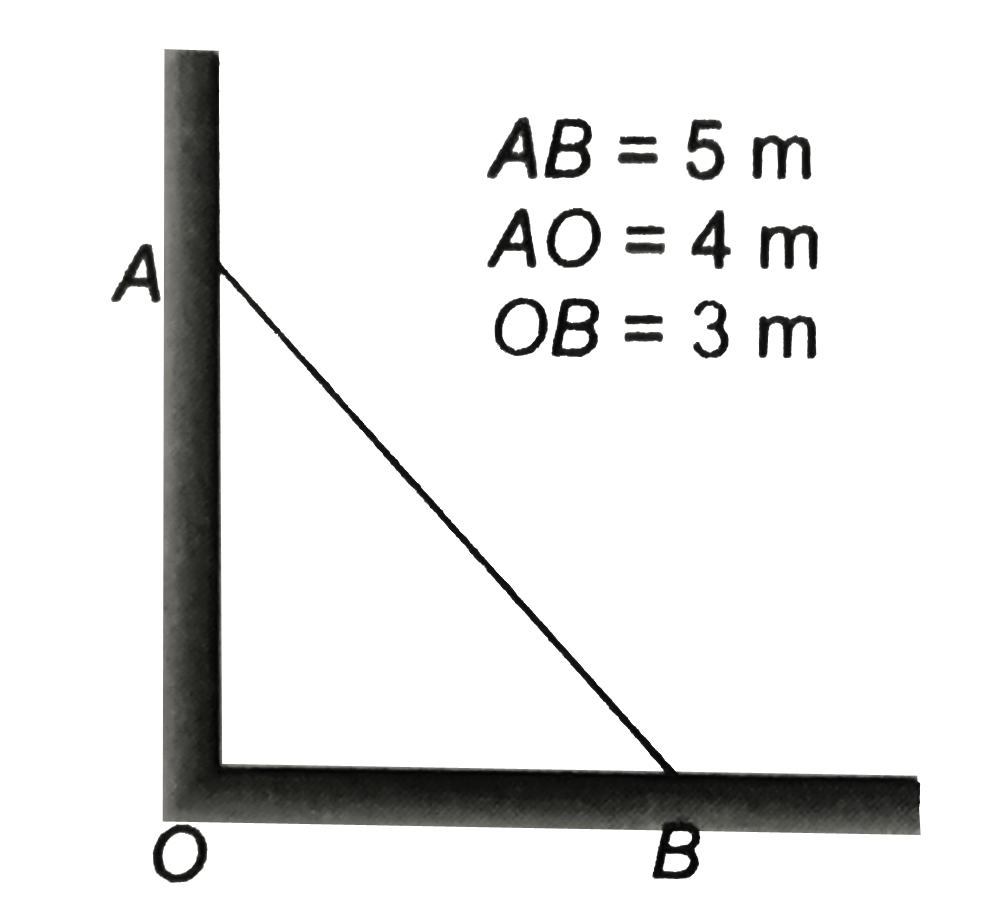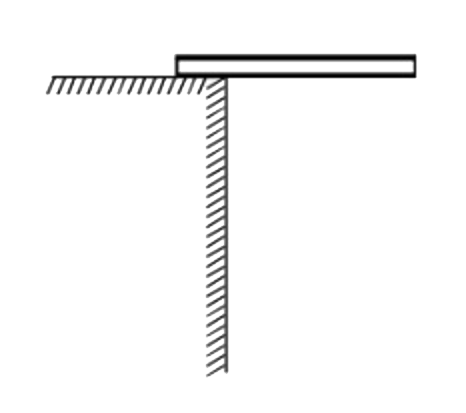Show that if a rod held at angle θ to the horizontal and released, its lower end will not slip if the friction coefficient between rod and ground is greater than 3sinθcosθ1+3sin2θ
To solve the problem, we need to analyze the forces and torques acting on the rod when it is released from an angle θ with respect to the horizontal. We will derive the condition under which the lower end of the rod does not slip.
1. Identify Forces Acting on the Rod:
- The weight of the rod (mg) acts downward at its center of mass, which is located at a distance of L2 from the lower end.
- The normal force (N) acts upward at the point of contact with the ground.
- The frictional force (f) acts horizontally at the point of contact, opposing the motion.
2. Torque Calculation:
- The torque (τ) about the point of contact due to the weight of the rod is given by:
τ=r×F=(L2cosθ)mgsinθ
- This simplifies to:
τ=mgL2sinθcosθ
3. Moment of Inertia and Angular Acceleration:
- The moment of inertia (I) of the rod about the point of contact is:
I=13mL2
- Using Newton's second law for rotation, we have:
τ=Iα
- Substituting the expressions for τ and I:
mgL2sinθcosθ=13mL2α
- This gives us:
α=3gsinθcosθL
4. Tangential Acceleration at the Center of Mass:
- The tangential acceleration (a_t) of the center of mass is related to angular acceleration:
at=α⋅L2=3gsinθcosθL⋅L2=3gsinθcosθ2
5. Force Analysis:
- The net force acting on the rod in the horizontal direction is given by:
f=mat=m⋅3gsinθcosθ2
- The frictional force must equal the force due to the tangential acceleration for the rod not to slip:
f=μN
6. Normal Force Calculation:
- The vertical forces give us:
N+f=mg
- Substituting for f:
N+3mgsinθcosθ2=mg
- Rearranging gives:
N=mg−3mgsinθcosθ2=mg(1−3sinθcosθ2)
7. Friction Condition:
- Now substituting N into the friction equation:
μN=3mgsinθcosθ2
- Thus:
μ(mg(1−3sinθcosθ2))=3mgsinθcosθ2
- Dividing through by mg (assuming m ≠ 0):
μ(1−3sinθcosθ2)=3sinθcosθ2
- Rearranging gives:
μ=3sinθcosθ2(1−3sinθcosθ2)
8. Final Expression:
- After simplifying, we find:
μ>3sinθcosθ1+3sin2θ
- This is the condition for the rod not to slip.
- The weight of the rod (mg) acts downward at its center of mass, which is located at a distance of L2 from the lower end.
- The normal force (N) acts upward at the point of contact with the ground.
- The frictional force (f) acts horizontally at the point of contact, opposing the motion.
- The torque (τ) about the point of contact due to the weight of the rod is given by:
τ=r×F=(L2cosθ)mgsinθ
- This simplifies to:
τ=mgL2sinθcosθ
- The moment of inertia (I) of the rod about the point of contact is:
I=13mL2
- Using Newton's second law for rotation, we have:
τ=Iα
- Substituting the expressions for τ and I:
mgL2sinθcosθ=13mL2α
- This gives us:
α=3gsinθcosθL
- The tangential acceleration (a_t) of the center of mass is related to angular acceleration:
at=α⋅L2=3gsinθcosθL⋅L2=3gsinθcosθ2
- The net force acting on the rod in the horizontal direction is given by:
f=mat=m⋅3gsinθcosθ2
- The frictional force must equal the force due to the tangential acceleration for the rod not to slip:
f=μN
- The vertical forces give us:
N+f=mg
- Substituting for f:
N+3mgsinθcosθ2=mg
- Rearranging gives:
N=mg−3mgsinθcosθ2=mg(1−3sinθcosθ2)
- Now substituting N into the friction equation:
μN=3mgsinθcosθ2
- Thus:
μ(mg(1−3sinθcosθ2))=3mgsinθcosθ2
- Dividing through by mg (assuming m ≠ 0):
μ(1−3sinθcosθ2)=3sinθcosθ2
- Rearranging gives:
μ=3sinθcosθ2(1−3sinθcosθ2)
- After simplifying, we find:
μ>3sinθcosθ1+3sin2θ
- This is the condition for the rod not to slip.
Topper's Solved these Questions
- ROTATIONAL MECHANICSBOOK - DC PANDEY ENGLISHCHAPTER - ROTATIONAL MECHANICSEXERCISE - Subjective Questions
2 Videos
- ROTATIONAL MECHANICSBOOK - DC PANDEY ENGLISHCHAPTER - ROTATIONAL MECHANICSEXERCISE - Level 2
1 Videos
- ROTATIONBOOK - DC PANDEY ENGLISHCHAPTER - ROTATIONEXERCISE - (C) Chapter Exercises
39 Videos
- ROTATIONAL MOTIONBOOK - DC PANDEY ENGLISHCHAPTER - ROTATIONAL MOTIONEXERCISE - Integer Type Questions
17 Videos
Similar Questions
Find the maximum and minimum values of cos2θ−6sinθcosθ+3sin2θ+2.
View SolutionSolve the following equation: 3cos2θ−2 √3sinθcosθ−3sin2θ=0
View SolutionSolve the following equation: 3cos2θ−2 √3sinθcosθ−3sin2θ=0
View SolutionSolve the following equation: 3cos2θ−2 √3sinθcosθ−3sin2θ=0
View SolutionA ladder of length 5m is placed against a smooth wall as shown in figure. The coefficient or friction is μ between ladder and ground. What is the minimum value of μ , If the ladder is not to slip?

View SolutionOne - fourth length of a uniform rod is placed on a rough horizontal surface and it starts rotating about the edge as soon as we release it. The rod starts slipping on the edge when it has turned through an angle θ. If the coefficient of friction between rod and surface is μ, and it satisfies the relation xtanθ=4μ, then what is the value of x? [Take g=10m/s2]

View SolutionProve that cos6θ+sin6θ=1−3sin2θcos2θ
View Solution(2+√3)sinθ+2cosθ lies between
View SolutionThe maximum value of the expression 1sin2θ+3sinθcosθ+5cos2θ
View SolutionA sphere can roll on a surface inclined at an angle θ if the friction coefficient is more than 27gsinθ. Suppose the friction coefficient is 17gsinθ, and a sphere is released from rest on the incline,
View Solution
